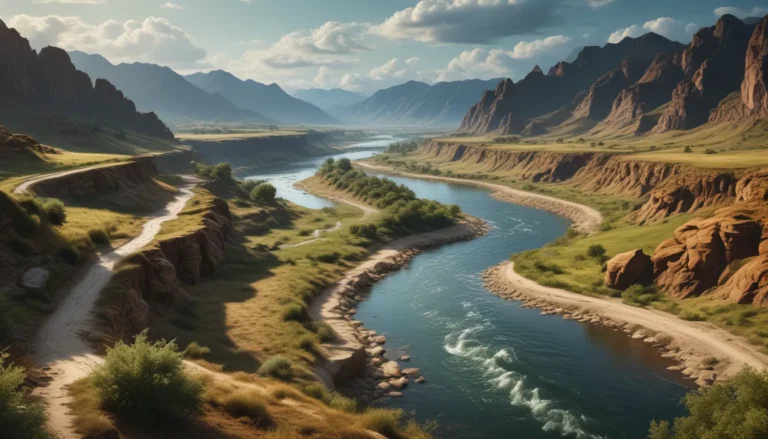A Note About Images: The images used in our articles are for illustration purposes only and may not exactly match the content. They are meant to engage readers, but the text should be relied upon for accurate information.
The Earth is a dynamic and ever-changing planet, and one of the most captivating processes that shape its surface is tectonic rifts. These geological wonders occur when the Earth’s crust separates, creating enormous chasms and valleys that stretch across vast distances. From the iconic Great Rift Valley in East Africa to underwater rifts at the bottom of the ocean, tectonic rifts have fascinated scientists and explorers for centuries.
Unveiling the Mysteries of Tectonic Rifts
Tectonic rifts, also known as rift valleys, are geographic formations that occur when the Earth’s lithosphere (the outer layer of the planet) is subjected to tectonic forces that cause it to split and separate. These rift valleys play a crucial role in shaping the Earth’s surface and have a significant impact on our planet’s geological features.
The Great Rift Valley: A Natural Wonder
One of the most famous examples of a tectonic rift is the Great Rift Valley in East Africa, which stretches over 3,700 miles and is visible from space. This iconic rift valley showcases the ongoing process of plate tectonics over millions of years, offering a glimpse into the dynamic nature of our planet’s geology.
The Formation and Impact of Rifts
Tectonic rifts form when the Earth’s crust is subjected to tensional forces, causing it to stretch and thin. This process, known as rifting, leads to the creation of rift valleys, mountain ranges, and volcanic activity. These geological formations not only shape the landscape but also play a vital role in the creation of new oceans and the uplift of mountain ranges.
Exploring Mid-Ocean Ridges and Rift Valleys
Tectonic rifts are responsible for the formation of mid-ocean ridges, where new oceanic crust is created as magma rises to fill the gap between separating tectonic plates. Rift valleys, on the other hand, often contain lakes and showcase the intricate interactions between geological forces and natural water bodies.
The Fascinating East African Rift System
The East African Rift System is an active tectonic rift that is slowly pulling apart, resulting in the formation of new rift valleys and potential future ocean basins. This dynamic geological feature offers scientists valuable insights into the processes of plate tectonics and continental drift.
The Connection Between Rifts and Volcanic Activity
Tectonic rifts are frequently associated with volcanic activity, as the thinning of the Earth’s crust allows magma to rise to the surface, leading to the formation of volcanoes. These volcanic eruptions not only shape the landscape but also contribute to the creation of mineral-rich deposits and influence the Earth’s climate.
Human Settlements and Tectonic Rifts
Human settlements have often arisen in areas surrounding tectonic rifts, attracted by the fertile soils, abundant water sources, and geothermal energy potential. While these regions may be at risk of seismic activity, they also offer unique opportunities for scientific research and geothermal energy extraction.
Unlocking Geological Time Through Rifts
Tectonic rifts are a testament to the ever-changing nature of the Earth’s surface, demonstrating the ongoing process of plate tectonics over millions of years. By studying these geological phenomena, scientists gain a deeper understanding of Earth’s geological history and the mechanisms behind continental drift.
The Significance of Rifts in Scientific Research
Tectonic rifts provide valuable opportunities for scientific research, allowing scientists to study the Earth’s interior, seismic activity, and the mechanisms behind continental drift. By exploring these rifts, researchers can unravel the mysteries of Earth’s geological processes and gain insights into the forces that shape our planet.
In conclusion, tectonic rifts are geological phenomena that shape the Earth’s surface and have a significant impact on our planet. These rifts are formed when tectonic plates move apart, creating rift valleys, mountain ranges, and even new ocean basins. The study of tectonic rifts allows scientists to better understand the dynamic nature of the Earth and its ever-changing features. From the Great Rift Valley in Africa to the mid-Atlantic ridge, these tectonic rifts provide us with a wealth of fascinating insights into our planet’s history and future.
Frequently Asked Questions About Tectonic Rifts
Q: What causes tectonic rifts?
A: Tectonic rifts are caused by the movement of tectonic plates, influenced by various factors such as convection currents in the Earth’s mantle and the interaction between different tectonic boundaries.
Q: How long does it take for a tectonic rift to form?
A: The formation of a tectonic rift can take millions of years, involving the gradual separation of tectonic plates and the accumulation of geological processes that shape the rift valleys and other landforms.
Q: Are tectonic rifts dangerous?
A: Tectonic rifts are associated with seismic activity, including earthquakes and volcanic eruptions. While they can be potentially dangerous, proper monitoring and understanding of these geological features can help mitigate risks and ensure the safety of affected populations.
Q: Are there any famous tectonic rifts?
A: Yes, one of the most famous tectonic rifts is the Great Rift Valley in Africa, which stretches over 6,000 kilometers and is home to stunning landscapes, diverse wildlife, and several large lakes.
Q: Can tectonic rifts affect climate change?
A: Tectonic rifts can indirectly influence climate change through their impact on the Earth’s crust and the release of greenhouse gases during volcanic eruptions. However, the primary driver of climate change is anthropogenic factors such as greenhouse gas emissions from human activities.
Exploring the wonders of tectonic rifts opens up a world of geological marvels and scientific discoveries. These captivating natural phenomena not only shape our planet’s surface but also provide valuable insights into Earth’s dynamic processes. By delving into the mysteries of tectonic rifts, we gain a deeper appreciation for the forces that continually mold our planet and the intricate beauty of our geological landscape. So, grab your geological helmets and embark on an adventure into the captivating world of tectonic rifts!






